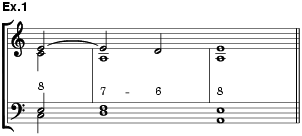
(Fr. basse; Ger. Bass; It. basso).
The lower part of the musical system, as distinguished from the treble, specifically: that part or voice in a composition executed by the lowest-range performers (‘bass part’); the lowest pitch in a sonority; hence the succession of lowest notes in a passage or composition (‘bass line’); the lowest segment of an instrument’s range, or the lowest octave or octaves articulated in a composition (‘bass register’); and those notes which ‘support’ the other parts, which determine the harmonic identity of sonorities and which are in the main responsible for harmonic progressions, cadences, modulations and large-scale tonal relationships (‘harmonic’, ‘functional’ or ‘musical’ bass). These distinct but overlapping meanings are all usually simply called ‘bass’. They share the original modifying sense ‘low’, as in Bass (ii) and (iii); ‘bass’ is cognate with the adjective ‘base’ (‘low’, ‘unrefined’), both deriving from Late Latin ‘bassus’ (‘low’, ‘thick’, ‘fat’).
The term first appeared in music about the middle of the 15th century: in expanding from three- to four-part texture, composers wrote two contratenor parts, the lower of which was distinguished by the title ‘contratenor bassus’. By 1500 ‘Bassus’ alone was used as a noun, meaning the lowest part in a composition. In this new sense it rapidly acquired two cognates, one material, the other figurative: the nouns ‘base’ (‘lowest or supporting part’) and ‘basis’ (‘main constituent’, ‘fundamental principle’). Thus Glarean’s confusion in the Dodecachordon of 1547 (MSD, vi, 1965): ‘The lowest voice is called ‘bass’ (Basis) … because all voices lean on it as a support’ (i, 122); ‘From this the common name ‘bass’ (Bassus) has by chance come into use’ (ii, 247). Soon afterwards the term acquired philosophical legitimacy through the humanistic conceit of comparing the four human voice ranges with the four elements, as in Zarlino’s Le istitutioni harmoniche of 1558 (trans. Marco and Palisca, 179):
As the earth is the foundation of the other elements, the bass (Basso) … is the foundation of the harmony, … as if to say the base (Basa) and sustenance of the other parts. If … the element of earth were lacking, what ruin and waste would result! Similarly a composition without a bass would be full of confusion and dissonance.
These conflated meanings ‘bass’, ‘base’ and ‘basis’ have persisted to the present.
Zarlino’s usage ‘foundation’ became more common in the Baroque era, where the basso continuo assumed ‘fundamental’ importance. The continuo instruments were often called ‘foundation instruments’, and ‘Fundamento’ was a common title on bass parts. Thus Walther in the Musicalisches Lexicon (1732), 268: ‘“Fundamento” is, in general, any bass part; in particular, a basso continuo; also the harmony which the latter expresses’. Although ‘Fundamento’ rarely occurred after 1750, the generic term ‘Basso’ designated the bass in soloistic chamber music as late as Haydn's string quartets op.20 (1772), and in orchestral music and informal chamber music until 1800. Haydn discussed scorings of the bass part in a letter of 1768 as follows: ‘I prefer just three basses [Bässe] – that is, one cello, one bassoon, and one double bass’; here ‘bass’ is still the generic term for any and all bass instruments. The modern practice of identifying every bass instrument by name in musical sources was not fully established until the 19th century.
The history of musical basses forms part of the history of Tonality. Features that are taken to be characteristic appeared from the 14th century on: movement of the lowest part primarily by leap (Ciconia), articulation of the final at cadences by leap from the 5th above (Du Fay, Binchois), expansion of the tessitura downwards to encompass the full range of the bass voice (Ockeghem, Josquin), and homophonic style ‘leaning’ on the bass (the frottola). Besseler and Lowinsky argued that these features functioned in Renaissance polyphony as they have in major–minor tonality since 1700. More recently, however, it has been shown that this music was still based on the earlier ‘discant theory’. The tenor was still the ‘basis’; the ‘skeleton’ was the note-against-note counterpoint between tenor and soprano, and the bass was an ‘added’ part not only in compositional practice (as is believed), but in theory. Thus Aaron, in his Thoscanello de la musica (1529/R), described ex.1 as a cadence on E, governed by the suspension–resolution configuration 8–7–6–8 (see also Cadence). But in tonality the ‘outer parts’, that is an expressive melody and a supporting bass, are the ‘skeleton’ of the music. The distinction is especially clear in early Baroque monody, where these two parts make up the entire notated texture.

Furthermore, Renaissance theorists still thought in terms of intervals. For Zarlino the triad was merely the most complex and perfect collection of intervals; he did not invoke the concept of chordal inversion, which, along with that of root, was first adumbrated just after 1600 in England and especially Germany. The ‘basis’ of tonality is the triad as a unified entity built on its bass: ‘the lowest of the three notes which constitute a triad is called the bass [Basis] or fundamental note’ (Brossard, Dictionaire, 2/1705/R, 169).
Finally, coherence in tonal music depends on the bass, which governs harmonic progressions, cadences (hence phrases and periods) and large-scale tonal relationships (hence form). Especially for large-scale relationships, no ‘basis’ of this kind has been shown for Renaissance polyphony.
The Baroque basso continuo incorporated every aspect of ‘bass’, being the bass part ‘by definition’. It occupied the lowest register and was virtually always the lowest-sounding part; it was often a true line of melodic and contrapuntal interest; even more often it was the ‘basis’ of the form, as in the ostinato, the passacaglia and other variations, and numerous dance-related patterns; and it not only supported the other parts but, through the figures supplied, determined the entire harmonic contents. As late as C.P.E. Bach the theory and practice of composition itself were, for most practical purposes, synonymous with mastery of the continuo. Hence Mattheson’s apotheosis (in Der vollkommene Capellmeister, 1739/R, 104) is less extravagant than may at first appear: ‘Musical composition could not exist without the continuo; the one assumes the other; and the continuo was born at the same time as harmony itself’. Furthermore the continuo was articulated more strongly than any other part: in performance, by timbral and often by registral doubling between a keyboard instrument (organ, harpsichord, clavichord) and a melody instrument (cello, double bass, viola da gamba, bassoon etc.); in register, by separation from the melodic parts above it, as in solo sonata and trio sonata scoring; and often in musical structure, by its independent musical material and specifically bass-like character and progressions (ex.2). Continuo parts often assumed one of a number of definite types, such as ostinato, figural, walking or stationary basses. Finally, tonality itself was one prerequisite for the rise of autonomous instrumental art music, one of the signal achievements of the Baroque age; but as has been seen, tonality is dependent on the bass.
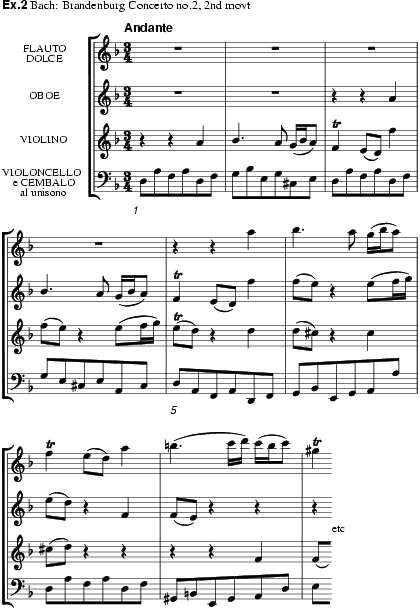
In the Classical and Romantic periods the hegemony of the continuo was broken in both theory and practice. Rameau’s distinction between the ‘actual’ bass (the lowest pitch) and an ‘ideal’ bass (the root) once again split ‘base’ and ‘basis’ into separate entities. The succession of roots, or Fundamental bass, determined the nature of the harmonies, by its restriction to the ‘functions’ I, IV and V, and of harmonic progressions, by its preference for movement by 5ths and 3rds. This basis for tonal music lived on in the ‘functional harmony’ of Riemann and his followers.
Meanwhile a number of independently scored instruments began to share the continuo’s old function of ‘base’. By late Haydn and Beethoven, there were separate cello, double bass and bassoon parts. Often the horn functioned on its own as the bass; occasionally the timpani and, in exceptional cases, the contrabassoon and trombone assumed this role. In the 19th century the last two instruments became standard, and tubas, the bass clarinet and bass trumpet were added, as well as other inventions most of which have since disappeared. Each of these bass instruments was now a separate ‘part’, with its own name, staff in the score and musical substance; each could at any time be the bass, the others resting or playing above it. Hence the musical bass was no longer correlated with any single part; rather it became identified, by and large, with the ‘bass line’ – the succession of lowest-sounding pitches – the chief denotative sense it retains.
Under these conditions the parts could ‘cross’ in a meaningful way. Koch noted this new resource, so characteristic of chamber music, as early as 1782 in his Versuch einer Anleitung zur Composition (i, 245–6): ‘When in a trio or quartet with obbligato cello [as opposed to continuo], the latter has solo passages, and the viola or second violin takes over the bass, … there is an exchange of bass function among the participating instruments’; this exchange is illustrated in ex.3. Haydn’s basses are transitional in this respect: in these ‘part-crossing’ passages the nominal bass often functions as the musical bass, as a continuo would have done. Mozart and Beethoven almost always took the view that the lowest part must be the bass.
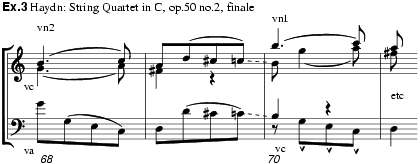
The bass retained all its harmonic, tonal and structural importance in Classical and Romantic music. In the hands of composers like Mozart or Chopin, even the much-maligned Alberti, ‘murky’ and ‘oompah’ basses were fully compatible with the highest art (see exx.4–5). Tovey wrote: ‘A composer [Schubert] whose basses are magnificent is a great contrapuntist, even if (like Wagner) he never published a fugue in his life’ (Essays and Lectures on Music, London, 1949, p.112). By the same token Brahms did not return to the ‘values’ of the Baroque era so much as he integrated his basses, at once melodic and structural, into complex textures and widely ranging harmonies.
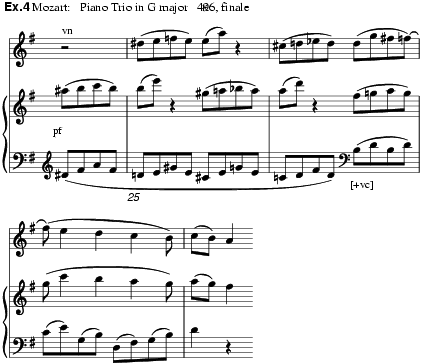
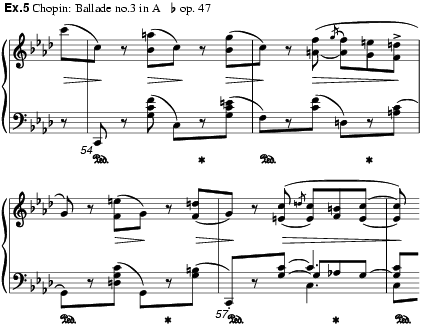
In the 20th century tonally based art music developed no new general principles in its basses. Composers like Stravinsky, Hindemith and Bartók partly replaced harmonic progressions of the traditional type with repetitive patterns such as the ostinato. In 12-note and other rigorously non-tonal music, it may be doubted whether the bass any longer functions as a ‘base’ or ‘basis’ at all. On the other hand, jazz and popular music maintain strongly articulated bass lines as the foundation of their subdominant-orientated tonality.
Schenker’s theoretical writings of the 1920s and 30s reinterpreted the bass as a synthesis of harmonic and contrapuntal forces: a line developed by prolongation of the triad in the form I–V–I. At the same time, in conjunction with the Schenkerian Urlinie, the bass retained its old importance as one of the two elements of the Ursatz or Aussensatz, the ‘outer parts’ in a structural as well as auditory sense. The marriage of bass and tonality remains indissoluble.
M. Shirlaw: The Theory of Harmony (London, 1917/R)
M. Schneider: Die Anfänge des Basso Continuo und seiner Bezifferung (Leipzig, 1918/R)
F.T. Arnold: The Art of Accompaniment from a Thorough-Bass (London, 1931/R)
F. Oberdörffer: Der Generalbass in der Instrumentalmusik des ausgehenden 18. Jahrhunderts (Kassel, 1939)
H. Besseler: Bourdon und Fauxbourdon (Leipzig, 1950)
H.H. Eggebrecht: ‘Studien zur musikalischen Terminologie (Mainz, 1955), 62ff.
C. Bär: ‘Zum Begriff des “Basso” in Mozarts Serenaden’, MJb 1960–61, 133–55
E. Lowinsky: Tonality and Atonality in 16th Century Music (Berkeley, 1961)
C. Dahlhaus: Untersuchungen über die Entstehung der harmonischen Tonalität (Kassel, 1967; Eng. trans., 1990)
E.T. Cone: ‘Beyond Analysis’, PNM, vi (1967–8), 33–51
H. Haack: Anfänge des Generalbass-Satzes: die ‘Cento concerti ecclesiastici’ (1602) von Ludovico Viadana (Tutzing, 1974)
S. Bonta: ‘From Violone to Violoncello: a Question of Strings?’, JAMIS, iii (1977), 64–99
J. Webster: ‘The Bass Part in Haydn’s Early String Quartets’, MQ, lxiii (1977), 390–424
R.J. Hoyt: The Bassline in Atonal Music: its Relationship to Melodic and Harmonic Structure (diss., U. of Pennsylvania, 1979)
M. Cyr: ‘Basses and basse continue in the Orchestra of the Paris Opéra, 1700–1764’, EMc, x (1982), 155–70
W. Salmen, ed.: Kontrabass und Bassfunktion (Innsbruck, 1986)
L. Dreyfus: Bach's Continuo Group: Players and Practices in his Vocal Works (Cambridge, MA, 1987)
C.-H. Mahling: ‘Con o senza fagotto? Bemerkungen zur Besetzung der “Bassi” (1740 bis ca.1780)’, ibid., 197–208
S.A. Edgerton: The Bass Part in Haydn's Early Symphonies: a Documentary and Analytical Study (diss., Cornell U., 1989)
J. Lester: Between Modes and Keys: German Theory, 1592–1802 (Stuyvesant, NY, 1989)
JAMES WEBSTER